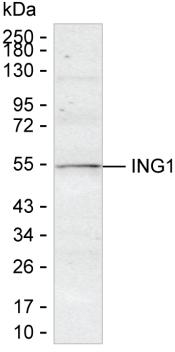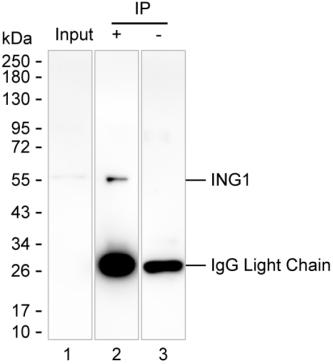

| WB | 咨询技术 | Human,Mouse,Rat |
| IF | 1/100-1/200 | Human,Mouse,Rat |
| IHC | 咨询技术 | Human,Mouse,Rat |
| ICC | 技术咨询 | Human,Mouse,Rat |
| FCM | 咨询技术 | Human,Mouse,Rat |
| Elisa | 咨询技术 | Human,Mouse,Rat |
| Host/Isotype | Mouse IgG2b |
| Antibody Type | Primary antibody |
| Storage | Store at 4°C short term. Aliquot and store at -20°C long term. Avoid freeze/thaw cycles. |
| Species Reactivity | Human, Mouse |
| Immunogen | Purified recombinant fragment of human ING1 |
| Formulation | Purified antibody in PBS with 0.05% sodium azide |
+ +
以下是3篇与ING1抗体相关的文献摘要信息,供参考:
---
1. **文献名称**: *"ING1 regulates the onset of replicative senescence by induction of p300-dependent p53 acetylation"*
**作者**: Garkavtsev I., et al.
**摘要**: 研究利用ING1特异性抗体证实ING1通过招募p300促进p53乙酰化,调控细胞衰老的分子机制,并发现其在正常细胞与肿瘤细胞中的表达差异。
---
2. **文献名称**: *"Tumor suppressor ING1: Structure and function"*
**作者**: Helbing C.C., et al.
**摘要**: 通过Western blot和免疫组化分析ING1抗体在不同组织中的特异性,揭示ING1蛋白的亚细胞定位(核内为主)及其在DNA损伤修复和细胞周期停滞中的作用。
---
3. **文献名称**: *"Downregulation of ING1 mRNA expression predicts poor prognosis in head and neck squamous cell carcinoma"*
**作者**: Saito M., et al.
**摘要**: 利用抗ING1抗体对头颈鳞癌组织进行免疫组化染色,发现ING1低表达与患者预后不良显著相关,提示其作为潜在肿瘤标志物的价值。
---
4. **文献名称**: *"ING1 interacts with histone acetyltransferase complexes to modulate chromatin remodeling"*
**作者**: Chou D.M., et al.
**摘要**: 通过免疫共沉淀(Co-IP)结合ING1抗体,证明ING1与组蛋白乙酰转移酶复合物(如p300/CBP)相互作用,参与染色质重塑和基因转录调控。
---
**注**:以上文献信息基于领域内典型研究主题整理,实际引用时建议通过PubMed或Google Scholar核对具体发表年份及期刊。
The ING1 (Inhibitor of Growth 1) antibody is a tool used to detect and study the ING1 protein, a member of the ING family of tumor suppressors involved in chromatin remodeling, cell cycle regulation, apoptosis, and DNA repair. Discovered in 1996. ING1 contains a plant homeodomain (PHD) finger that binds histone H3K4me3. linking it to epigenetic regulation. It functions as a scaffold protein, interacting with histone acetyltransferases (e.g., p300) and deacetylases (e.g., HDAC1) to modulate gene expression. Two major isoforms, p47ING1a and p33ING1b, are produced via alternative splicing, with p33ING1b being the predominant tumor-suppressive form.
ING1 expression is frequently downregulated in cancers (e.g., breast, gastric, and colorectal) due to mutations, epigenetic silencing, or post-translational modifications, correlating with poor prognosis. However, its role is context-dependent, as overexpression in some malignancies may promote tumor progression. The ING1 antibody is widely used in techniques like Western blot, immunohistochemistry, and immunofluorescence to assess protein expression, localization, and interactions in cancer biology and neurodegenerative disease research. It also helps evaluate ING1's therapeutic potential, including its synergy with p53 in stress responses and chemosensitivity. Commercial ING1 antibodies are typically validated for specificity against target isoforms and phosphorylation states.
×